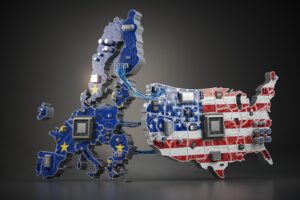Climate and Trade in a World of Resurgent Industrial Policy
|
Excerpts from a piece by Resources for the Future, from a discussion on climate and trade hosted at Georgetown University in February. Few citizens and governments consider the current system of international trade beneficial to climate action today, and many worry about the distribution of outcomes. Although free trade has been instrumental in the reduction of global poverty and the expansion of the global middle class, many in industrialized nations feel that the international trade system has shipped manufacturing jobs and activity overseas and left behind a weakened middle class. In the world of climate policy, international competition between firms is making industrial decarbonization more difficult, due to the risk (or fear) that firms operating in nations with more stringent climate policies simply may relocate to nations where emissions are less stringently regulated, yielding a situation known as carbon leakage. Can the trade system change? Radical changes have tended to reflect major shifts in geopolitics or macroeconomics. The Bretton Woods system of trade rules was shaped by the United States, which reflected the nation’s new role as a superpower following World War II and an interest in avoiding the mistakes following World War I; namely, the protectionist tariffs that fomented economic depression. The General Agreement on Tariffs and Trade grew into the World Trade Organization after many rounds of liberalizing trade by reducing tariff and non-tariff barriers, with the hope that the gains of trade would spread to the developing world in the era after the Cold War. Today, geopolitical realities and the goals in the Paris Agreement may call for a further institutional overhaul of the global trade system. The global push to achieve net-zero emissions demands unprecedented action, albeit at different speeds in different countries, given the Paris Agreement’s bottom-up architecture based on nationally determined contributions, and the United Nations Framework Convention on Climate Change principle of “common but differentiated responsibilities.” The goals of the agreement require policy choices that are not easily reconciled with the trading system that has existed since 1989. …A reformed international trade system ideally would recognize the political motivations behind new green industrial policies and trade policies, while still encouraging restraint, fairness, and the scope of any policy to stay in proportion to its purpose. A tax credit in the Inflation Reduction Act may be a fantastic incentive to produce clean hydrogen, but if the tax credit becomes the sole business case for clean hydrogen, few countries will be able to compete with firms in the United States. Border adjustment mechanisms may be legally legitimate to level the playing field between firms that operate in nations with more stringent climate policies and firms in nations with less stringent climate policies, but the costs of complying with border adjustment mechanisms may be disproportionate, especially for countries in the Global South or for smaller producers. These challenges are not cause for such policies to be avoided or abandoned, but policymakers may want to account for the impacts of these policies on trade partners or political partners, as well. |
|
The US-EU Trade and Technology Council has Been a Success. Now Build on that Success.
L. Daniel Mullaney served as Assistant US Trade Representative for Europe and the Middle East from 2010 to 2023. The following are excerpts from a blog post published by the Atlantic Council.
Two and a half years ago, officials from the United States and the European Union (EU) met in Pittsburgh for the inaugural session of the US-EU Trade and Technology Council (TTC). Their aim was to “coordinate approaches to key global technology, economic, and trade issues and to deepen transatlantic trade and economic relations, basing policies in shared democratic values.” Four additional TTC meetings followed in Europe and the United States, and a sixth will take place in April in Belgium. At this meeting, the co-chairs will have an opportunity to consider some of the lessons learned since the first meeting in 2021. While in most respects the TTC has been a success, there are several ways in which it could now be made even better.
Specifically, the TTC should incorporate a trade agreement framework informed by regular formalized stakeholder input. This framework would focus on (1) avoiding the full range of trade barriers arising from new technologies and (2) tailoring cooperative efforts in a way that allows the United States and the EU to promote their shared values globally and prevents small disagreements from impeding progress. Significantly, a trade agreement foundation for trade and technology cooperation would create huge efficiencies and go a long way toward ensuring US-EU engagement on issues of common interest from administration to administration and from commission to commission.
…US-EU trade fora have, for decades, been a bit ad hoc, designed and developed by particular US administrations or EU commissions, only to be reformulated and reinvented after the next election. That reinvention has several negative effects: It takes significant time and negotiating effort to reinvent procedures. It lacks the durability of an ongoing framework, even though the substance of the subsequent discussions often remains similar. And it lacks a structured mechanism for receiving and incorporating stakeholder input across the broad range of trade issues—input that is critical to anticipating commercially meaningful potential barriers and to identifying and pursuing joint global objectives.
|
US Sets Trade Policy Sights on China’s Xinjiang
The US is mulling an end to the de minimis provision that allows shipments valued under US$800 to enter the world’s largest consumer market, a move largely aimed at Chinese exports. Such a move would escalate a raft of trade controls Washington has already placed against China, including controls on semiconductor technology and outbound investment.
In many ways, a key piece of legislation impelling the momentum is the US Uyghur Forced Labor Prevention Act (UFLPA). Passed in late 2021, the ambition of the UFLPA is far more comprehensive than the “small yard, high fence” scope of containment policies, as it seeks to restrict imports in toto from an entire region inextricably linked to global supply chains. Growing political pressure and technical know-how within the retooled oversight agencies portend much more robust UFLPA enforcement across a growing category of goods.
This is likely to be one of the more conspicuous developments in the US’ international trade posture in 2024. The Biden administration signaled last week that it may escalate controls on China’s access to sophisticated semiconductor technologies, as Commerce Secretary Gina Raimondo vowed “we will do whatever it takes.” Alongside these tech controls, Washington has existing policy weapons it could use to target the extent to which Xinjiang is embedded in global supply chains, including in strategic industries suffused with Chinese overcapacity. Early signs of enhanced enforcement action suggest a particular focus on the automotive sector.
Washington’s new trade Zeitgeist
The Biden administration has never quite succinctly enunciated its trade doctrine. Reindustrializing the country, de-risking, and an emphasis on labor rights and the environment have been moving parts of a vast policy machine.
A renewed focus on supply chains, which have become ever more complex and specialized as globalization has advanced, is at the core of this otherwise disparate agenda.
The UFPLA is a case in point and epitomizes the complexity and scope of Washington’s new trade agenda. In the words of international trade law expert John Foote, the UFLPA is “the most trade impacting law that was not actually crafted as trade legislation. It was adopted, ultimately as a piece of human rights legislation”.
The core raison d’etre for the UFPLA is the extensive body of evidence suggesting that forced labor is an integral pillar of Beijing’s objective to eradicate or at least Sinicize Uyghur Muslim culture, through coercing Uyghurs into adopting the lifestyles and values of China’s Han majority.
|
Nearshoring: A Strategic Tool for Resilient Electronics Supply Chains
Electronics manufacturers face the urgent task of strengthening their supply chains amid trade disputes, geopolitical tensions, and the unpredictable impact of climate change events. Making sure everything runs smoothly, works well, and stays secure is key to long-term success. For manufacturers of electronic products, it’s crucial to keep a close eye on every step of the process, from getting parts to making and delivering products.
To combat these multifaceted challenges, many are now turning to reshoring and nearshoring strategies. These approaches build resiliency into supply chains and provide solutions to the pressing issues manufacturers confront daily.
Diversified Supply Chains are More Resilient
Electronics companies today are relying more on supply chain and manufacturing diversification as a key strategy. This approach acts as a vital shield against growing trade tensions, political uncertainties and the increasing occurrence of natural disasters.
By spreading their sources for electronics components, locations for sourcing, and manufacturing bases, companies are fortifying themselves against potential disruptions. This strategy not only improves their bargaining power but also enhances their agility in responding to market demand shifts.
Embracing Nearshoring for Supply Chain Diversification
Nearshoring plays a pivotal role in diversifying supply chains by relocating manufacturing operations closer to end markets. This approach helps companies reduce their reliance on single-sourcing locations and lowers the risk of disruption. By spreading production across multiple geographic regions, nearshoring creates a supply chain that is both resilient and flexible.
Moreover, nearshoring offers easier access to local suppliers and resources, allowing companies to quickly adapt to changes in market demand and supply chain dynamics. For electronics companies seeking to diversify their supply chains, nearshoring is a powerful tool to increase resilience against disruptions.
|
|
|
|





